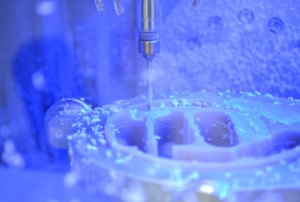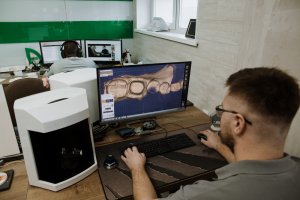CAD/CAM dentistry is dentistry, typically restorative dentistry, that uses CAD/CAM technology to create dental prostheses, like crowns, veneers, and dentures.
CAD stands for computer-aided design, and CAM stands for computer-aided manufacturing. This technology was created by the manufacturing industry in 1957 and adopted by dentistry in 1985.
CAD/CAM in dentistry has resulted in more efficient, cost-effective, and accurate processes for creating restorations. As the technology continues to improve, so too will the prospects for anyone who needs dental prostheses.
In this article you’ll learn all about CAD/CAM dental technology, including:
- How it works
- What it’s used for
- How it’s revolutionizing restorative dentistry
Read on to find out more about the exciting world of dental tech!
What is CAD/CAM dentistry?
Computer-aided design (CAD) and computer-aided manufacturing (CAM) are digital technologies used to design, plan and ultimately create dental prosthodontics with 3D printing technology. With CAD/CAM, dentists can efficiently create dental crowns, teeth bridges, veneers, onlays, inlays, dentures, and dental implant-supported prostheses.
This technology uses a scanner and 3Dprinting technology to create a tooth that is perfectly fabricated and fitted for you.
It is used for implant design, crowns, bridges, veneers, partials, and everything else in dentistry; even Invisalign. It is an excellent, very reliable technology we use in modern dentistry today to bring amazing care that is of high quality to our patients.


This technology creates things that look very real. It gives longevity to the restorations because they are so perfectly adapted to your teeth.
Dr. Rhonda Kalasho, Glo Modern Dentistry
How does CAD/CAM dentistry work?
Before CAD/CAM, the process of getting crowns, implants, and dentures involved various dental visits. Your dentist would make molds of your teeth and then send them on to a lab. There, technicians would make your new teeth.
The CAD/CAM process for making dental restorations is much more efficient and can be completed in as a little as 45 minutes, and at most a couple of hours. If your dentist is going to create your dental prostheses with CAD-CAM technology, here’s what you can expect:


- Preparation: During your appointment, your dentist will need to remove any decay and make sure your teeth are clean and ready to receive restorations.
- Scanning: Your dentist will use an intraoral scanner to create 3D images of your mouth and teeth.
- Design: Dentists or staff will use these 3D images along with CAD software to digitally plan, draw and design the restoration. This can take anywhere from a few minutes to an hour, depending on the experience of your dentist, and the complexity of the restoration.
- Milling: This is where the digital smile design becomes reality. The bridge, denture, inlay, onlay, crown, implant, or veneer is milled from a block of ceramic material in a special milling chamber.
- Customization: Your new tooth is tailored to match the rest of your teeth, with customized stains and glazes for a natural look.
- Firing: Just like with pottery, your ceramic tooth will be fired in an oven.
- Final adjustments: After the firing, your dentist will polish the restoration to perfection and then it’s time for placement.
In the video below you can watch the milling process of a CEREC CAD CAM procedure to create a crown:
Components of CAD/CAM dental technology
Various tools and technology are used in CAD/CAM dentistry:
- Scanner: Also called a digitalization tool, the scanner scans and transforms the images of your teeth into the computer to be processed.
- CAD software: This is used to process the images of your teeth and plan your custom dental prostheses. This software can also show you your predicted treatment results.
- CAM machine: This machine transforms your dental scans into the actual restoration via 3D printing.
How is CAD/CAM different than traditional dental restoration?
There are some crucial differences between CAD/CAM dentistry and conventional restoration, including time and effort required from the clinician and the patient.
We mentioned the process for CAD/CAM above—now let’s have a quick look at traditional restorative dentistry:
- Your dentist will take your dental impression.
- This impression gets sent to a lab.
- The lab technician mounts the impression and makes a dental cast.
- Using the cast, the dentist makes a crown, veneer, etc.
- While the restoration is being made, the patient will have a temporary restoration until the final tooth is finished.
It can take two to three appointments at least to complete the above steps. With CAD/CAM dentistry, there is no need for manual dental impressions ot be taken, or for tedious lab work and multiple appointments. What’s more, the results with CAD/CAM are more precise and aesthetically pleasing.
You can have a look at the table below for a summary of the differences between CAD/CAM and traditional restorations:
Conventional restoration | CAD/CAM restoration | |
Material | Ceramic/resin | Ceramic/resin |
Number of appointments | Multiple | Single appointment |
Aesthetics | Good results | Most accurate |
Teeth preparation | Lots of prep required for cement and temporization | More conservative and precise preparation |
Dental impressions | Manual via plastic/metal trays and impressions | Digital scanning only |
Price | Cheaper | More expensive |
Dental CAD/CAM also makes orthodontic treatment easier, because using this technology, dentists can take digital scans of a patient’s teeth, which are faster and more accurate than making molds. These scans can be used with software, making the planning and delivery of treatment easier and faster, especially when it comes to invisible braces.
What’s more, patients can see the potential results of their orthodontic treatment before they even begin. Another benefit of CAD/CAM (for any sort of dental treatment) is that it’s easier for those patients who have a strong gag reflex that makes it more difficult to make dental impressions.
Pros and cons of CAD/CAM
While there are many advantages to CAD/CAM dentistry, there are some drawbacks as well. Let’s have a quick look at a summary of the pros and cons:
Pros of CAD/CAM
- Faster treatment time
- Easier treatment
- Convenient for patient
- More comfortable processes for patient
- More precise
- Best aesthetics
Cons of CAD/CAM
- More expensive
- Extra training required
- Some patients may not like the opacity of the restoration
It is important to know that not every tooth or case is suitable for this tech treatment. Your dentist will decide if that is possible or not.
Your eligibility also depends on the type of restoration and the materials that will be used in restoration. And in some challenging cases, dentists prefer traditional methods, giving them more control in preparing the restoration and ensuring the right fit.
Dr. Eyad Tariq
Conclusion


Dental CAD/CAM is a relatively new technology that can improve the patient experience during dental treatment. It also makes creating restorations easier for dentists as well, resulting in better-looking replacement teeth and a more comfortable experience overall.
Because this technology is still quite new, there are limitations and it’s more expensive than conventional restoration techniques.
If you’re interested in this type of restorative dentistry, you can talk to your dentist about your options.
FAQs
What is CAD/CAM dentistry?
CAD/CAM dentistry is a new technology that uses computer-aided design and computer-aided manufacturing to create dental restorations with digital scans and 3D printing.
How much does CAD/CAM dental cost?
CAD/CAM dental costs are higher than normal restorative dental procedures because it’s still relatively new and requires advanced technology and machinery such as 3D printing.
Is CAD/CAM better than traditional restorative dentistry?
CAD/CAM is not necessarily better than traditional restorative dentistry, but neither is traditional dentistry better than CAD/CAM. Different techniques will be better for different people. The important thing is to take care of your oral health and get restorative treatment when your dentist says you need it.
IOPScience: The Application of CAD/CAM Technology in Dentistry. Consulted 26 April 2021.




